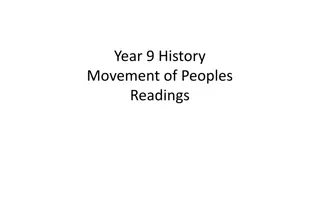Key Concepts of Colonization in North America: 1607-1754
Europeans from Spain, France, the Dutch, and England established colonies in North America with differing economic and imperial goals. Spain aimed for strict control and exploitation, while the French and Dutch focused on trade partnerships with Native Americans. English colonization attracted a large number of immigrants seeking economic prosperity, religious freedom, and better living conditions. Each group faced unique challenges and interactions with Native American tribes.
Download Presentation

Please find below an Image/Link to download the presentation.
The content on the website is provided AS IS for your information and personal use only. It may not be sold, licensed, or shared on other websites without obtaining consent from the author.If you encounter any issues during the download, it is possible that the publisher has removed the file from their server.
You are allowed to download the files provided on this website for personal or commercial use, subject to the condition that they are used lawfully. All files are the property of their respective owners.
The content on the website is provided AS IS for your information and personal use only. It may not be sold, licensed, or shared on other websites without obtaining consent from the author.
E N D
Presentation Transcript
www.Apushreview.com Period 2: 1607 - 1754 APUSH Review: Key Concept 2.1 Everything You Need To Know About Key Concept 2.1 To Succeed In APUSH Updated for the 2015 revisions
Time Period 2 Big Ideas Key Concept 2.1 Europeans developed a variety of colonization and migration patterns, influenced by different imperial goals, cultures, and the varied North American environments where they settled, and the competed with each other and American Indian for resources. Page 30 of the Curriculum Framework Big ideas: What were similarities in colonization among the Spanish, French, Dutch, and English? What were the experiences like with Native Americans with these European countries? How and why did slavery evolve in these colonies? How did climate and geography affect British colonies?
Key Concept 2.1, I Spanish, French, Dutch, and British colonizers had different economic and imperial goals involving land and labor that shaped the social and political development of their colonies as well as their relationships with native populations. - Page 30of the Curriculum Framework A) Spain established strict control over colonization and converted and exploited many natives A major goal of Spain was to make $ All trade must go through a few Spanish controlled ports Small amount of Spaniards ruled indigenous population Spain sought to convert natives to Christianity, forced many into the encomienda system, and used as trading partners B) French and Dutch colonization: Both countries sent few Europeans and built relationships with the Natives French intermarried with natives and built extensive trading partnerships Coureurs de bois French fur traders trade beaver furs; would live among natives Dutch Like the French, the Dutch build extensive trade routes mostly in NY Encouraged settlement of the New World New Netherland
Key Concept 2.1, I C)English Colonization: Large number of immigrants Both male and female unlike other European countries Sought economic prosperity, religious freedom (Puritans), and better living conditions (England was overcrowded) English colonies also welcome immigrants from other countries Colonies were based on agriculture Tobacco became a large cash crop Headright system encouraged immigrants benefitted the wealthy Unlike the French and Spanish, English colonists sought to live separately from Native Americans Conflicts with natives Powhatans, Bacon s Rebellion, Pequot War, King Philip s War
Key Concept 2.1, II In the 17th century, early British colonies developed along the Atlantic coast, with regional differences that reflected various environmental, economic, cultural, and demographic factors. - Page 31of the Curriculum Framework A) Chesapeake colonies (MD and VA) and North Carolina: Relied heavily on tobacco plantations developed long work days and growing seasons Exhausted land led to expansion and conflicts with natives (Bacon s again!) Up to the late 17th century, most labor was made up of indentured servants After Bacon s Rebellion (1676), there was a switch to African slavery B) New England colonies: Established by Puritans (wanted to purify the Anglican Church John Winthrop) Established small towns with small farms Schools were established for towns with 50 families; extended families were common Some agriculture, fishing, commerce Boston becomes a major port city Colder climate, rocky terrain did not allow large plantations
Key Concept 2.1, II C) Middle Colonies: Tended to be the most diverse demographically, religiously, and ethnically Quakers in Pennsylvania (William Penn) religiously tolerant Women in Pennsylvania had more rights Quakers allowed women equal positions in church Immigrants from Germany Economy was based on the exportation of cereal crops - wheat D) Southern colonies and West Indies: In South Carolina and Georgia, rice was a major staple crop Very arduous labor long days and long growing season Many white laborers refused to work in rice fields led to an increase in slave labor In the West Indies (Barbados) sugar cultivation was a major part of the economy Like South Carolina and Georgia, slave labor was heavily used In many instances, slaves made up a majority of the population Led to the development of slave codes laws to regulate slave behavior Gave incredible power to slave owners
Key Concept 2.1, II E) Emergence of democratic, self-government in the British colonies: Caused by: Distance from Britain Lax attention (Salutary Neglect hands-off approach to the colonies) New England colonial government: Town meetings -> elected legislatures White, land-owning, church members could vote Southern colonial government: Planters dominated assemblies Virginia House of Burgesses 1st representative government in British colonies, many members were elite plantation owners
Key Concept 2.1, III Competition over resources between European rivals and American Indians encouraged industry and trade and led to conflict in the Americas. - Page 32of the Curriculum Framework A) Atlantic economy: Exchange of goods, African Americans, and Native Americans between Europe, Africa, and the Americas European colonies focused on producing goods to Europe (Mercantilism) Goods that were valued in Europe were exported from the colonies (fur, tobacco, etc.) New sources of labor -> Native American labor, indentured servants, and African slave labor B) Impacts of trade on Natives: Cultural changes Natives lost land, many Europeans sought to assimilate them Economic changes Land was lost and altered by Europeans Demographic changes drastic decrease in population due to diseases
Key Concept 2.1, III C) Interactions between Natives and Europeans: Fostered (promoted the growth of) both accommodation and conflict Europeans allied with Native groups against opposing Native groups Pequot War, Metacom s War British were able to offer more goods to natives, whereas the French were more tolerant of natives (and intermarried with natives) During the French and Indian (7 Years) War, almost all natives were allied with the French not the Iroquois D) European and colonial interests often varied: Both sides increasingly distrusted each other British colonists sought to expand (especially post 7 Years War), Britain forbade it Frontier defense became a major issue seen in Bacon s Rebellion Trade divided the two groups colonists smuggled to get around British taxes
Key Concept 2.1, III E) British and Native American conflicts: Were caused by: Competition over land, resources, and boundaries Led to military conflicts: Metacom sWar (King Philip s War) see video in description Conflict between Natives and British colonists in New England Natives were defeated, not much of a threat thereafter in New England F) Spanish and Native American resistance: Pueblo Revolt: Pueblo Indians successfully overthrew the Spanish for 12 years After the Spanish regained control, they became more accommodating to Native American culture, particularly religion
Test Tips Multiple-Choice and Short Answer Questions: Goals of European colonization Differences between British and other colonies Comparing British colonies (geography, religion, economy) Essay Questions: Reasons for the development of slavery Comparing and Contrasting European colonization French, Spanish, and English























